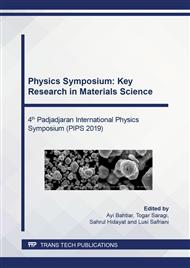p.274
p.282
p.288
p.297
p.303
p.310
p.315
p.320
p.329
Metal-Polymer Composite as an Acoustic Attenuating Material for Ultrasonic Transducers
Abstract:
This work reports the acoustic evaluation of a tungsten-epoxy composite which is functioned as a backing material of an ultrasonic transducer. The composite is prepared by mixing tungsten powder in epoxy at a weight ratio of 4:1 using a shaker milling and curing the mixture under a vacuum condition. The sound velocity and acoustic attenuation in the prepared composite is measured by propagating a 200-kHz ultrasonic wave with a through transmission mode. The prepared composite is subsequently assembled with a 1-MHz piezoelectric disk (PZT-8) and an epoxy layer as the active element and the matching layer, respectively, into a fabricated ultrasonic transducer. A square-wave burst pulse is used as an excitation signal for the evaluation of the fabricated transducer. The generated ultrasonic wave shows a higher damping in the presence the backing layer. In addition, the measured sound velocity and acoustic attenuation of prepared composite showed that the ratio of 4:1 is sufficient composition in order to apply as a backing material. In conclusion, control the transducer characteristics is determined by the acoustic properties of tungsten-epoxy composite.
Info:
Periodical:
Pages:
303-309
Citation:
Online since:
August 2020
Price:
Сopyright:
© 2020 Trans Tech Publications Ltd. All Rights Reserved
Share:
Citation:


